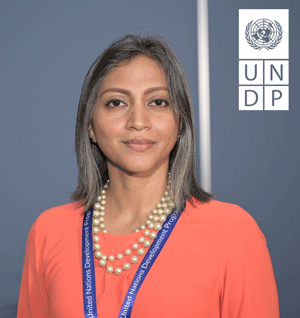UN proposes Debt-for-Nature swap to Sri Lanka

Dr. Vagisha Gunasekara
A UN agency has proposed a Debt-for-Nature Swap (DFNS) as part of a medium-term strategy in responding to Sri Lanka’s economic crisis.
A Policy Memorandum on Urgent Macroeconomics and Human Development Priorities dated April 12, had been submitted by the United Nations Development Programme (UNDP) in the lead up to Sri Lanka’s negotiations with the International Monetary Fund (IMF), a spokesperson confirmed this week. A policy memo analyses an issue and offers recommendations to inform or guide a decision-maker, in the case Sri Lanka.
The Business Times in an exclusive report on June 26 headlined ‘Debt-for-nature swap to counter debt crisis’ focused on a call by experts suggesting a similar pathway.
When asked, UNDP Economist Dr. Vagisha Gunasekara said that while challenging, in the near to medium-term, it would be important to focus on re-profiling and/or taking on some new debt to channel resources to prioritise human development needs, while reducing interest payments.
“There are a number of financial instruments that can help Sri Lanka achieve this – Sustainable Development Goals (set by the UN)/Social/Sustainability bond type of borrowing and DFNS that advances environmental protection/conservation goals. Sri Lanka is currently discussing an IMF programme and preparing to enter negotiations for debt restructuring with creditors. The government could present their ideas for DFNS and/or any other type of bond instrument advancing human development and environmental goals during these meetings,” she told the Business Times. The gestation period for issuing such a bond or a swap is about 9-10 months. As for the type of DFNS, there are two types – ‘commercial’ (private) swaps and ‘bilateral’ (public) swaps, the Business Times understands.
Dr. Gunasekara explained that globally, the first DFNS in Bolivia, together with most of those designed during the 1980s and 1990s debt crises in Latin America, was ‘commercial’. Under this swap, a debt of a debtor government is traded on markets (e.g., through government bonds) in the restructuring process. A third-party organisation [usually a non-governmental organisation (NGO), another government or individuals) purchases the debt of a developing country in the secondary market at a discount price. This price reflects the market’s expectation on the possibility of repayment. In exchange, the debtor country commits to invest the full face-value in local currency in conservation projects, the spokesperson said.
The success of commercial DFNSs depends on the agreement on the discount rate on the outstanding debt – the higher the discount rate, the more debt can be restructured.
According to the UNDP these swaps had been popular in the 1980s. Due to the overall improved debt position of developing countries after several debt crises in the 1980s and 1990s and the subsequent debt relief efforts under initiatives like Heavily Indebted Poor Country (HIPC), the application of commercial DFNSs has been in decline since the mid-1990s.
Referring to ‘bilateral’ DFNSs, Dr. Gunasekara said the debt to be restructured is not traded on public markets. This debt is between the debtor government and creditor governments or a development bank. The creditor government or development bank agrees to forgive a portion of the debt in exchange for the debtor country’s financial contribution to conservation efforts.
“Sometimes an NGO provides additional resources to the debt-reduction commitment from the creditor, making it a ‘subsidised’ debt-swap, such as in the Seychelles. These bilateral DFNSs are mostly driven by the willingness of creditor countries and historically led by Paris Club members,” she pointed out.
Dr. Gunasekara said that the US is the single largest creditor involved in bilateral DFNSs. These have mainly been carried out through two facilities under USAID: The Tropical Forest Conservation Act (TFCA) introduced in 1998 and the Enterprise for the Americas Initiative (EAI), a predecessor of TFCA.
Asked whether UNDP has studied a DFNS programme for Sri Lanka, she said an in-depth study has not been undertaken as of yet. Such a study would be required prior to DFNS agreements. UNDP has the technical expertise to support the government “given our experience in assisting Indonesia, Uzbekistan, and Mexico in issuing their SDG bond; it could also help Sri Lanka”.
“There is a growing number of examples of successful DFNSs as well. UNDP reaffirms its commitment to working closely with relevant state institutions in supporting Sri Lanka’s fiscal and policy landscape for an inclusive economic recovery,” she said.
Citing an example, she added that on November 5, 2021, Belize signed a DFNS with The Nature Conservancy (TNC), an environmental organisation, which reduced the country’s external debt by a striking 10 per cent of GDP. The DFNS “more significantly”, greatly improved the prospects for marine protection.
Hitad.lk has you covered with quality used or brand new cars for sale that are budget friendly yet reliable! Now is the time to sell your old ride for something more attractive to today's modern automotive market demands. Browse through our selection of affordable options now on Hitad.lk before deciding on what will work best for you!


